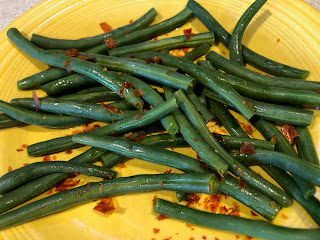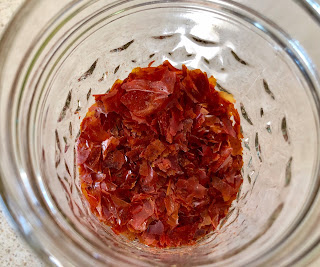
Recipe: Try tomato flakes or powder on popcorn, veggies, salads

|
You've sliced, diced, sandwiched, roasted, cobbled, canned and crushed your tomato crop. Now, before those tomatoes fade away completely, here's your chance to powder them.
I'd never thought of doing this until earlier this summer when I was making salsa to can. The tomatoes needed to be peeled, but I was using my lovely meaty Juliet cherry tomatoes. No way was I going to dip hundreds of these in hot water and peel them. Instead, I sliced them in half, put them cut side down on pans, and popped them under the broiler. Success! The skins slid right off.
Then I looked at the big pile of skins.
 |
| The dried tomato skins are ready to be crumbled. |
Hmm, I wondered, could I turn those into tomato powder?
In this case, it was a pretty easy yes. I already had pans out that I could reuse after scraping the Juliets off them.
I spread the skins across the parchment paper on the pans and returned them to the oven, this time set at 200 degrees. I put them in there for an hour or so. Then, just to be sure they were completely dry, I turned off the oven and left them there overnight. (If you have a dehydrator, this will be even easier.)
The skins the next morning crumbled easily. I loaded them all into my food processor and whirred them to flakes. If you want powder, just keep whirring. The powder stores beautifully in a glass jar on the spice shelf.
 |
| Tomato flakes are delicious on green beans. |
Tomato powder brightens up vegetables and salad dressings, but the most fun use is sprinkled over hot popcorn. Add some to the melting butter, then sprinkle on more. Game day snack, anyone?
Tomato powder
This is less of a recipe and more of a method. I used only skins, but you also could use leftover tomato pulp or even very thinly sliced tomatoes -- the drying will take longer, however.
Ingredients:
Tomato skins, enough to thinly cover at least one quarter-sheet baking pan (though as long as you're doing this, why not do several pans' worth?)
Instructions:
Heat oven to 200 degrees. Cover baking pans with parchment paper (preferred) or lightly grease them. Spread skins thinly and evenly over the pans, and put pans in the oven. Check after 1 hour to judge how much longer to keep the heat on. Skins may be already dry, especially if they were cooked as part of being removed from the tomatoes.
When everything seems dry, turn off the oven, leaving the pans inside for several hours or overnight to completely dry and cool.
Remove the tomato skins from the oven, and check that the skins crumble easily. Put them in a blender, food processor or spice blender. Whir until you have the consistency of flakes or powder you want.
(If the tomato skins are sticking to the side of the blender, they're not dry enough and need to be put back in the oven for awhile.)
 |
| Tomato flakes ready to store and use. |
Store powder in a clean closed glass jar at room temperature. Probably best to use it in six months for best flavor.
(Note on drying tomato pulp or thin slices: Use the lowest setting available on your oven, or use a dehydrator. Drying the tomatoes thoroughly may take as long as 18 hours.)
Comments
0 comments have been posted.Sacramento Digs Gardening to your inbox.
Sites We Like
Garden Checklist for week of April 21
This week there’s plenty to keep gardeners busy. With no rain in the immediate forecast, remember to irrigate any new transplants.
* Weed, weed, weed! Get them before they flower and go to seed.
* April is the last chance to plant citrus trees such as dwarf orange, lemon and kumquat. These trees also look good in landscaping and provide fresh fruit in winter.
* Smell orange blossoms? Feed citrus trees with a low dose of balanced fertilizer (such as 10-10-10) during bloom to help set fruit. Keep an eye out for ants.
* Apply slow-release fertilizer to the lawn.
* Thoroughly clean debris from the bottom of outdoor ponds or fountains.
* Spring brings a flush of rapid growth, and that means your garden is really hungry. Feed shrubs and trees with a slow-release fertilizer. Or mulch with a 1-inch layer of compost.
* Azaleas and camellias looking a little yellow? If leaves are turning yellow between the veins, give them a boost with chelated iron.
* Trim dead flowers but not leaves from spring-flowering bulbs such as daffodils and tulips. Those leaves gather energy to create next year's flowers. Also, give the bulbs a fertilizer boost after bloom.
* Pinch chrysanthemums back to 12 inches for fall flowers. Cut old stems to the ground.
* Mulch around plants to conserve moisture and control weeds.
* From seed, plant beans, beets, cantaloupes, carrots, corn, cucumbers, melons, radishes and squash.
* Plant onion sets.
* In the flower garden, plant seeds for asters, cosmos, celosia, marigolds, salvia, sunflowers and zinnias.
* Transplant petunias, zinnias, geraniums and other summer bloomers.
* Plant perennials and dahlia tubers for summer bloom.
* Mid to late April is about the last chance to plant summer bulbs, such as gladiolus and tuberous begonias.
* Transplant lettuce seedlings. Choose varieties that mature quickly such as loose leaf.